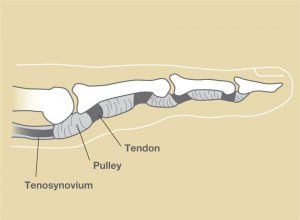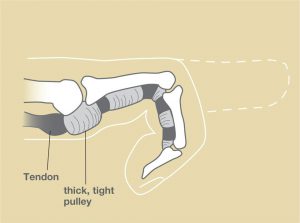Trigger Finger
Stenosing tenosynovitis, commonly known as trigger finger or trigger thumb, affects the pulleys and tendons that flex the fingers. Tendons act like ropes, connecting the muscles of the forearm to the bones of the fingers and thumb. In each finger, a series of pulleys forms a tunnel that guides the tendon smoothly, keeping it close to the bone. Trigger finger or thumb develops when the pulley at the base of the finger becomes thickened and constricted, making it difficult for the tendon to glide freely. Sometimes the tendon itself may develop a nodule or its lining may swell, which increases resistance to movement. This results in pain, a popping or catching sensation, and may cause the finger to become temporarily stuck or locked.
Causes
The exact causes of trigger finger or thumb are not always clear. In some cases, the condition is linked to systemic disorders such as rheumatoid arthritis, gout, or diabetes. Occasionally, local trauma to the palm or the base of the finger may contribute, but most often there is no obvious precipitating event.
Signs and symptoms
The condition typically begins with discomfort at the base of the affected finger or thumb, where it joins the palm. This area is often tender to the touch, and a small nodule may be present. As the condition progresses, the finger may catch or lock during movement, leading to the sensation that the problem is occurring at the joints even though the issue originates at the pulley.
Treatment
The goal of treatment is to eliminate the catching or locking of the finger and restore smooth, pain-free movement. Reducing swelling around the flexor tendon and its sheath is essential. Initial treatments may include:
- Wearing a splint or using oral anti-inflammatory medications
- Modifying activities to reduce strain on the tendon
- Receiving a steroid injection around the tendon and pulley to relieve inflammation
If these non-surgical methods do not provide adequate relief, surgery may be recommended. Outpatient surgical procedures, usually performed under local anesthesia, involve releasing the tight pulley to allow the tendon to glide freely. Patients typically begin active motion of the finger soon after surgery, with normal hand function gradually resuming as comfort improves. In some cases, prolonged tenderness, discomfort, or swelling may occur, and hand therapy might be necessary to fully restore function.
Key Takeaways


